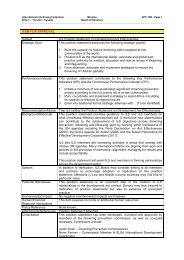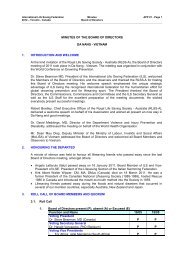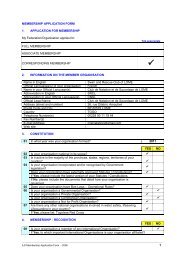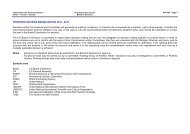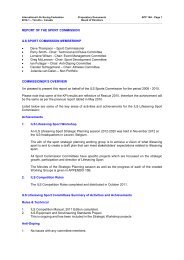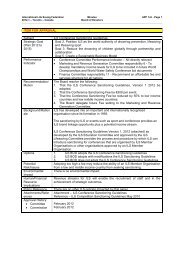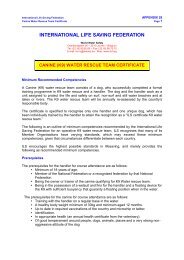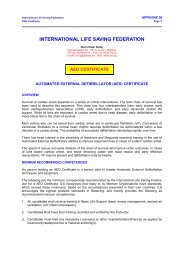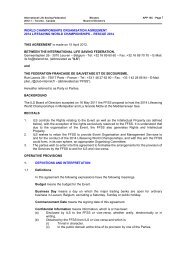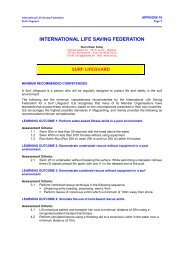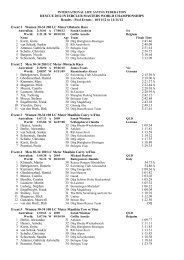BOD 2012-2 MIN APP 10C - IFA - ILS Beach Lifeguard Award.pdf
BOD 2012-2 MIN APP 10C - IFA - ILS Beach Lifeguard Award.pdf
BOD 2012-2 MIN APP 10C - IFA - ILS Beach Lifeguard Award.pdf
You also want an ePaper? Increase the reach of your titles
YUMPU automatically turns print PDFs into web optimized ePapers that Google loves.
International Life Saving Federation Minutes <strong>APP</strong> <strong>10C</strong> - Page 1<br />
<strong>2012</strong>-2 – Adelaide - Australia Board of Directors<br />
ITEM FOR <strong>APP</strong>ROVAL<br />
Subject<br />
<strong>Lifeguard</strong> and Lifesaver Qualifications and <strong>ILS</strong> Equivalency - <strong>ILS</strong> <strong>Award</strong><br />
Criteria – International <strong>Beach</strong> (Surf) <strong>Lifeguard</strong> <strong>Award</strong><br />
Strategic Goal<br />
No.2 – Position <strong>ILS</strong> as the international leader, advocate and global best<br />
practice authority for medical, education and rescue issues in lifesaving<br />
and lifeguarding.<br />
Performance Indicator The <strong>ILS</strong> is recognised as the world authority on drowning prevention.<br />
Recommendation/Motion 1. That the International Surf <strong>Lifeguard</strong> award be renamed “International<br />
<strong>Beach</strong> <strong>Lifeguard</strong>” award.<br />
2. That the Recommended Skill Sets and Competencies for the<br />
International <strong>Beach</strong> <strong>Lifeguard</strong> award be amended and updated as per<br />
the attached.<br />
Background/Rationale At the October 2010 meeting of the <strong>ILS</strong> Board held in Egypt, the Board<br />
noted the Lifesaving Commissioner’s report which stated:<br />
“I reported to the Board in Madrid that a self audit of member organisations<br />
ongoing compliance with <strong>ILS</strong> award equivalency would be conducted.<br />
During the conduct of this audit, and subsequent applications for <strong>ILS</strong> award<br />
equivalency, a number of compliance issues emerged. The Rescue and<br />
Education Committees are reviewing the awards for both competency and<br />
currency. In the meantime, while this review continues, all current awards<br />
will stand.”<br />
The Board was updated on the progress on this task at the meeting held in<br />
May 2011 in Vietnam. The resolution of the Board was: “The Board of<br />
Directors was informed that the equivalencies approved in the past would<br />
remain unchanged until a solution to the identified concerns can be found<br />
(anticipated April – May <strong>2012</strong>). The Lifesaving Commissioner agreed to<br />
include a European Member in these deliberations. The Board received<br />
unanimously (14: U) this information.”<br />
Dr Klaus Wilkins was nominated to act as the additional European member.<br />
The Working Group consisted of Martin O’Sullivan - Irish Water Safety,<br />
(Chair), Danny Bryant – SLSGB (Co-ordinate and circulate), Matt<br />
Thompson – SLSA, Peter Dawes – RNLI, Justin Bakinga - RLSS<br />
Cameroon and Klaus Wilkins – DLRG (representing Europe).<br />
The review of the International Surf <strong>Lifeguard</strong> <strong>Award</strong> commenced in 2009.<br />
Since the review began, the lifesaving commission and its subordinate<br />
committees have developed a number of drafts which moved between the<br />
criteria being prescriptive and generic. The debate has been extensive.<br />
The final version of the revised award criteria is positioned as generic. This<br />
direction was taken due to the variation in the development stage of<br />
member organisations and also the variation in available resources and<br />
local rescue techniques. The revised award criteria should allow most<br />
member organisations to achieve compliance with the criteria.<br />
Options<br />
<strong>ILS</strong> recognises that many of its Member Federations have standards that<br />
exceed these base criteria, based on the circumstances presented in their<br />
own countries. The <strong>ILS</strong> will continue to encourage the highest possible<br />
standards in lifeguarding, and provides its criteria as recommended<br />
minimum competencies.<br />
1. Adopt the award criteria as drafted.<br />
2. Consider amendments to the award criteria as proposed by the Board<br />
of Directors.<br />
3. Not adopt the criteria as an award of the <strong>ILS</strong>, that is, the current Surf
International Life Saving Federation Minutes <strong>APP</strong> <strong>10C</strong> - Page 2<br />
<strong>2012</strong>-2 – Adelaide - Australia Board of Directors<br />
Potential Risk/Issues<br />
<strong>Lifeguard</strong> award criteria remains in place.<br />
Adoption of the award criteria will assist <strong>ILS</strong> member organsations in<br />
working towards standard award criteria and consistency across global<br />
lifesaving.<br />
By going with a generic standard, there may be a variation in the actual<br />
level of ability of candidates accredited with the award. This could be<br />
avoided with a prescriptive standard.<br />
Environmental Impact<br />
Human/Financial<br />
Resource Implications<br />
However with a prescriptive standard, the reality is that due to the variation<br />
in lifesaving techniques and resources available to member organisations,<br />
it is unlikely that many member organisations will be able to achieve the<br />
prescribed criteria. This would result in non-compliance and a lack of<br />
uptake of the <strong>ILS</strong> award equivalency.<br />
There is no environmental impact.<br />
There are unlikely to be any significant human, financial or resource<br />
implications for the <strong>ILS</strong>.<br />
Policy Reference<br />
Attachments/References 1.<br />
Approval History:<br />
Rescue Committee<br />
Lifesaving<br />
Commission<br />
The financial and resource implications are with the body conducting the<br />
lifesaving activity, where the organisation may need to make adjustments in<br />
order to comply with the award criteria.<br />
Current <strong>ILS</strong> Surf <strong>Lifeguard</strong> award criteria in place.<br />
<strong>ILS</strong> <strong>Beach</strong> <strong>Lifeguard</strong> <strong>Award</strong> Criteria revised draft<br />
2. <strong>ILS</strong> Lifesaving Position Statement (LPS 07) – Fitness Testing for<br />
<strong>Lifeguard</strong>s<br />
3. <strong>ILS</strong> Surf <strong>Lifeguard</strong> <strong>Award</strong> Criteria (Original)<br />
4. SLSA Bronze Medallion/Cert II Public Safety (Aquatic Rescue)<br />
5. RNLI <strong>Beach</strong> <strong>Lifeguard</strong> <strong>Award</strong><br />
6. SLSGB <strong>Beach</strong> <strong>Lifeguard</strong> <strong>Award</strong><br />
7. SLSNZ Surf <strong>Lifeguard</strong> <strong>Award</strong><br />
September <strong>2012</strong><br />
September <strong>2012</strong>
International Life Saving Federation Minutes <strong>APP</strong> <strong>10C</strong> - Page 3<br />
<strong>2012</strong>-2 – Adelaide - Australia Board of Directors<br />
International <strong>Beach</strong> <strong>Lifeguard</strong><br />
Minimum Recommended Skill Sets and Competencies<br />
Training Requirement<br />
A ‘<strong>Beach</strong> <strong>Lifeguard</strong>’ is a person who will be regularly assigned to protect life and provide safety cover<br />
in both surf and non-surf environments. The operational environment places very specific demands on<br />
the skills and knowledge expected of a training and competent lifeguard.<br />
The following are the minimum skill sets recommended by the International Life Saving Federation for<br />
a <strong>Beach</strong> <strong>Lifeguard</strong>:<br />
1. Demonstrate a level of fitness to meet the operational requirement.<br />
2. Describe appropriate techniques for identifying potential casualties in the water.<br />
3. Describe the basic principles of managing aquatic (surf) and beach related emergencies.<br />
4. Demonstrate rescues with and without equipment.<br />
5. Demonstrate appropriate casualty care for common beach related injuries or illnesses.<br />
<strong>ILS</strong> recognizes that many of its Member Federations have standards that exceed these minimums,<br />
based on the circumstances presented in their own countries.<br />
<strong>ILS</strong> encourages the highest possible standards in lifeguarding, and merely provides the following as<br />
recommended minimum competencies.<br />
That the <strong>Beach</strong> <strong>Lifeguard</strong> <strong>Award</strong> should be re-assessed on a regular basis to ensure the lifeguard<br />
continues to meet the standards required.<br />
1. Demonstrate a level of fitness to meet the operational requirement<br />
Competency/Outcome Rationale Assessment Criteria<br />
i. Perform water-based<br />
fitness skills in a pool<br />
or open water<br />
environment.<br />
Candidates need to be pretested<br />
in a safe environment<br />
(i.e. pool) to ensure that they<br />
are safe to continue training<br />
in more challenging<br />
environments such as a surf<br />
beach. Organisations may<br />
feel it is appropriate to<br />
establish separate criteria for<br />
commencing training and for<br />
final testing.<br />
Requirement<br />
Organisations need to develop a standard<br />
that will ensure that candidates can<br />
demonstrate a level of fitness that will<br />
keep themselves safe for training and to<br />
perform to a benchmark that meets<br />
operational requirements.<br />
Guideline<br />
<strong>ILS</strong> has developed a policy relating to<br />
lifeguard fitness.<br />
ii.<br />
Demonstrate a level<br />
of fitness combined<br />
with applied<br />
knowledge and skills<br />
in an operational<br />
(surf or beach)<br />
environment.<br />
Testing of candidates for<br />
beach lifeguard<br />
competencies should include<br />
elements of testing in the<br />
operational environment.<br />
This element should be<br />
carried out as if for a rescue,<br />
showing urgency and speed.<br />
Recommended Minimum Standard<br />
Swim 400m within 8 minutes<br />
Requirement<br />
Organisations need to develop standards<br />
that will ensure candidates can perform<br />
required skills in the operational<br />
environment.<br />
Guideline<br />
Demonstrate running, wading, porpoising<br />
and swimming skills in a beach/surf<br />
environment.<br />
Recommended Minimum Standard<br />
Run-Swim-Run (Run 200 m, swim<br />
200 m and run 200 m) within 8<br />
minutes
International Life Saving Federation Minutes <strong>APP</strong> <strong>10C</strong> - Page 4<br />
<strong>2012</strong>-2 – Adelaide - Australia Board of Directors<br />
iii.<br />
Demonstrate lift and<br />
carry of casualty<br />
<strong>Lifeguard</strong>s will be required to<br />
lift and carry a casualty from<br />
the water to a position of<br />
safety on the beach<br />
Note: The Examiner in charge will have<br />
the discretion to extend the time due to<br />
varying environmental conditions, at all<br />
times ensuring the safety of the<br />
candidates, provided all candidates are<br />
informed prior to the commencement of<br />
the assessment.<br />
Demonstrate lift and carry of the<br />
casualty from the water to a position<br />
of safety on the beach<br />
Requirement<br />
Organisations need to develop standards<br />
that will ensure candidates can perform<br />
required skills in the operational<br />
environment.<br />
Guideline<br />
Demonstrate a lift and carry of casualty<br />
taking due consideration of occupational<br />
health and safety issues for both the<br />
casualty and the rescuer.<br />
iv<br />
Demonstrate a<br />
surface dive and<br />
underwater swim<br />
<strong>Lifeguard</strong>s need to be able to<br />
submerge to look for and<br />
recover an unconscious<br />
casualty<br />
Recommended Minimum Standard<br />
Demonstrate a lift and carry by a lone<br />
rescuer<br />
Demonstrate a lift and carry by<br />
multiple (i.e. 2) rescuers<br />
Requirement<br />
Organisations need to develop standards<br />
that will ensure candidates can perform<br />
required skills in the operational<br />
environment.<br />
Guideline<br />
Demonstrate an ability to surface dive<br />
and swim underwater.<br />
Recommended Minimum Standard<br />
Surface dive and swim underwater a<br />
distance of 6 to 10metres and<br />
demonstrate a simulated search pattern.<br />
2. Describe appropriate techniques for identifying potential casualties in the water<br />
Competency/Outcome Rationale Assessment Criteria<br />
i. Describe the<br />
characteristics of<br />
casualties in distress.<br />
<strong>Lifeguard</strong>s need to be able to<br />
identify at risk individuals and<br />
describe visual cues to<br />
identify a casualty in<br />
distress/drowning.<br />
Requirement<br />
<strong>Lifeguard</strong>s need to be able to identify<br />
casualties in order to illicit an appropriate<br />
response.<br />
Guideline<br />
Describe the characteristics of casualties<br />
in distress.<br />
ii.<br />
Describe surveillance<br />
methodology.<br />
<strong>Lifeguard</strong>s need to<br />
demonstrate an<br />
Recommended Minimum Standard<br />
Theory assessment<br />
Requirement<br />
Organisations need to develop standards
International Life Saving Federation Minutes <strong>APP</strong> <strong>10C</strong> - Page 5<br />
<strong>2012</strong>-2 – Adelaide - Australia Board of Directors<br />
understanding of issues<br />
related to maintaining<br />
effective surveillance of<br />
assigned areas of<br />
responsibility, including:<br />
Fatigue<br />
Briefing/change over<br />
procedures<br />
Etc<br />
that will ensure candidates can perform<br />
required skills in the operational<br />
environment.<br />
Guideline<br />
Describe surveillance methodology.<br />
Recommended Minimum Standard<br />
Theory assessment<br />
3. Describe the basic principles of managing aquatic (surf) and beach related<br />
emergencies<br />
Competency/Outcome Rationale Assessment Criteria<br />
i. Identify and describe<br />
the operational<br />
environment, related<br />
risks and local<br />
resources<br />
<strong>Lifeguard</strong>s should have a<br />
preparation phase where<br />
they inform themselves of the<br />
potential resources available<br />
in an emergency.<br />
Requirement<br />
<strong>Lifeguard</strong>s should be aware of the<br />
resources available to them as support<br />
and how to access those resources.<br />
Guideline<br />
ISO-31000 and the <strong>ILS</strong> Risk Assessment<br />
Guidelines provide a methodology as to<br />
the information required to inform the<br />
preparedness of a lifeguard operation<br />
ii.<br />
iii.<br />
Operational<br />
communications<br />
within a lifeguard<br />
team.<br />
Communicate safety<br />
information to the<br />
public.<br />
<strong>Lifeguard</strong>s should be aware<br />
of the need to communicate<br />
relevant operational<br />
information within the<br />
lifeguard team to ensure a<br />
coordinated response and<br />
relay safety critical<br />
information during a rescue.<br />
<strong>Lifeguard</strong>s should be aware<br />
of the need to communicate<br />
relevant safety information<br />
to the public both pre-arrival<br />
and on beach to prevent<br />
emergencies.<br />
Recommended Minimum Standard<br />
Theory assessment<br />
Requirement<br />
<strong>Lifeguard</strong>s should be aware of the<br />
importance of communication when<br />
responding to aquatic emergencies.<br />
Guideline<br />
Demonstrate <strong>ILS</strong> approved hand signals<br />
Recommended Minimum Standard<br />
Scenario or theory assessments.<br />
Requirement<br />
<strong>Lifeguard</strong>s should be aware of the<br />
resources available to educate the public<br />
and of the importance of preventative<br />
responses.<br />
Guideline<br />
<strong>ILS</strong> provides guidance safety messages<br />
appropriate to a range of environments<br />
and activities.<br />
Recommended Minimum Standard<br />
Scenario or theory assessments.
International Life Saving Federation Minutes <strong>APP</strong> <strong>10C</strong> - Page 6<br />
<strong>2012</strong>-2 – Adelaide - Australia Board of Directors<br />
3. Describe the basic principles of managing aquatic (surf) and beach related<br />
emergencies<br />
Competency/Outcome Rationale Assessment Criteria<br />
iv.<br />
Demonstrate<br />
principles of dynamic<br />
risk assessment and<br />
managing<br />
emergencies.<br />
<strong>Lifeguard</strong> will be faced with<br />
a range of potential hazards<br />
and emergencies, not all of<br />
which can be covered in<br />
training. It is therefore<br />
important for the lifeguard to<br />
understand the basic<br />
principles of applying their<br />
skills and knowledge to<br />
emergent situations.<br />
Requirement<br />
<strong>Lifeguard</strong>s should be familiar with the<br />
principles of dynamic risk assessment<br />
and managing emergencies.<br />
Guideline<br />
ISO-31000 and the <strong>ILS</strong> Risk Assessment<br />
Guidelines provide a methodology that a<br />
lifeguard will be required to apply using<br />
skills and knowledge to develop and<br />
implement strategies to manage<br />
emergencies.<br />
Identify hazards<br />
<br />
<br />
Evaluate risk<br />
Treat the risk<br />
1. Identify and select strategies for<br />
water rescues and emergencies.<br />
2. Identify and solve potential<br />
problems for putting plans into<br />
place.<br />
3. Design a basic emergency<br />
management plan.<br />
4. Practice emergency action plan.<br />
5. Review and modify emergency<br />
management plan.<br />
Recommended Minimum Standard<br />
Scenario assessment<br />
4. Demonstrate rescues with and without equipment<br />
Competency/Outcome Rationale Assessment Criteria<br />
i. Demonstrate rescues<br />
with equipment<br />
Candidates should<br />
demonstrate competency on<br />
equipment that they would be<br />
expected to use<br />
operationally.<br />
Requirement<br />
Organisations need to develop standards<br />
that will ensure candidates can perform<br />
required skills in the operational<br />
environment and utilise equipment<br />
relevant to the organisations operations.<br />
Guideline<br />
<strong>ILS</strong> organisations utilise a range of<br />
equipment types. Skills should be<br />
assessed in the operational environment.<br />
ii.<br />
Demonstrate rescues<br />
without equipment<br />
While it is recommended that<br />
equipment should always be<br />
used for rescues it is<br />
recognised that lifeguards<br />
may become separated from<br />
Recommended Minimum Standard<br />
Perform rescue of conscious<br />
casualty<br />
Perform rescue of unconscious<br />
casualty<br />
Perform rescue with land based<br />
equipment<br />
Requirement<br />
<strong>Lifeguard</strong>s should be familiar with<br />
casualty assessment, approaches and<br />
support/tows. Consideration should also<br />
be given to teaching escapes and
International Life Saving Federation Minutes <strong>APP</strong> <strong>10C</strong> - Page 7<br />
<strong>2012</strong>-2 – Adelaide - Australia Board of Directors<br />
their equipment or encounter<br />
rescue situations when<br />
equipment is not available<br />
(i.e. during training).<br />
releases.<br />
Guideline<br />
Skills should be assessed in the<br />
operational environment.<br />
Recommended Minimum Standard<br />
Demonstrate a safe approach and<br />
an escape or release<br />
Perform rescue of conscious<br />
casualty<br />
Perform rescue of unconscious casualty<br />
5. Demonstrate appropriate casualty care for common beach related injuries or illnesses<br />
Competency/Outcome Rationale Assessment Criteria<br />
i. Demonstrate basic<br />
life support<br />
<strong>Lifeguard</strong>s must have the<br />
skills necessary to provide<br />
casualty care to a drowning<br />
victim.<br />
Requirement<br />
<strong>Lifeguard</strong>s should be able to provide BLS<br />
to the drowning victim, including<br />
recognition of an emergency, ability to<br />
call an emergency response number,<br />
competence in chest compressions and<br />
in rescue breathing.<br />
Guideline<br />
ILCOR or Local resuscitation council or<br />
equivalent.<br />
ii.<br />
Demonstrate<br />
casualty care (first<br />
aid)<br />
<strong>Lifeguard</strong>s should<br />
demonstrate competency to<br />
manage casualties with a<br />
range of illnesses and<br />
injuries common in an<br />
aquatic (beach/surf)<br />
environment.<br />
Recommended Minimum Standard<br />
Demonstrate BLS, preferably on a<br />
resuscitation manikin<br />
Scenario and theory assessments.<br />
Requirement<br />
<strong>Lifeguard</strong>s need to be able to identify<br />
and perform first aid techniques for<br />
managing injury and emergency<br />
including:<br />
<br />
<br />
<br />
<br />
Casualty management<br />
Identify and managing injuries (i.e.<br />
shock, fractures, arterial and venal<br />
bleeding, spinal injury etc.)<br />
Use of appropriate rescue and first<br />
aid equipment.<br />
Documenting as per organisational<br />
requirements<br />
Guideline<br />
ILCOR or local resuscitation council or<br />
equivalent<br />
Recommended Minimum Standard<br />
Scenario and theory assessments.<br />
Range of Variables<br />
There are a number of variables that will affect the performance and assessment of the learning<br />
outcomes. These may include:<br />
Facilities<br />
Facilities and use of varying open water aquatic locations. Conditions of the venue. Identification<br />
of equipment that is available for use at that location.
International Life Saving Federation Minutes <strong>APP</strong> <strong>10C</strong> - Page 8<br />
<strong>2012</strong>-2 – Adelaide - Australia Board of Directors<br />
<br />
<br />
<br />
Dress<br />
Candidates may be required to wear their recognised uniform; long shirt and pants or short shirt<br />
and pants during the assessment.<br />
Candidates<br />
Candidates will have relevant lifesaving experience and will be seeking or currently employed as a<br />
lifeguard.<br />
Resources<br />
<strong>ILS</strong> member organisations will list and identify the use of theoretical and practical resources<br />
available to them.



